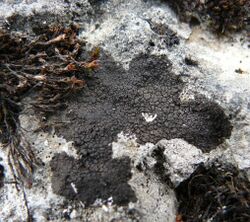Biology:Verrucaria
| Verrucaria | |
|---|---|

| |
| Verrucaria nigrescens, Schwäbische Alb, Germany | |
| Scientific classification | |
| Domain: | Eukaryota |
| Kingdom: | Fungi |
| Division: | Ascomycota |
| Class: | Eurotiomycetes |
| Order: | Verrucariales |
| Family: | Verrucariaceae |
| Genus: | Verrucaria Shrad. (1794) |
| Type species | |
| Verrucaria rupestris Shrad. (1794)
| |
| Species | |
|
about 150 accepted species | |
| Synonyms | |
| |
Verrucaria is a genus of lichenized (lichen-forming) fungi in the family Verrucariaceae.[1]
Taxonomy
The genus was circumscribed by German botanist Heinrich Adolph Schrader in 1794, with Verrucaria rupestris assigned as the type species. In his brief diagnosis of the genus, Schrader mentioned the more or less spherical (subglobose), closed ascomata, and the crustose thallus.[2] The genus name is derived from the Latin word verruca (meaning "wart") and the suffix -aria (meaning "belonging to" or "possession").[3]
Ecology
As of 2015, there were 16 Verrucaria species classified as marine species: V. adguttata, V. allantoidea, V. ceuthocarpa, V. corallensi, V. ditmarsica, V. erichsenii, V. halizoa, V. halochlora, V. microsporoides, V. paulula, V. psychrophila, V. sandstedei, V. serpuloides, V. sessilis, V. subdiscreta, and V. thalassina.[4]
Species
- Verrucaria ahtii – Finland
- Verrucaria kiyosumiensis – Japan
- Verrucaria nigrescens – widespread
- Verrucaria oulankaensis – Finland
- Verrucaria rhizicola – France
- Verrucaria rupestris
- Verrucaria serpuloides – a permanently submerged marine lichen in Antarctica[5]
- Verrucaria takagoensis – Japan
- Verrucaria vitikainenii – Finland
Distribution
Verrucaria ditmarsica has been recorded in 1984 from the Lighthouse Island, Copeland Island, County Down, Northern Ireland.[6]
See also
- Hydropunctaria maura, formerly Verrucaria maura, one of the most widespread lichens on the European littoral zone and found worldwide
References
- ↑ "Using a multigene phylogenetic analysis to assess generic delineation and character evolution in Verrucariaceae (Verrucariales, Ascomycota)". Mycological Research 111 (Pt 10): 1145–68. 2007. doi:10.1016/j.mycres.2007.08.010. PMID 17981450.
- ↑ Schrader, Heinrich Adolf (1794). Spicilegium Florae Germanicae. Hannover: Ritscher. p. 108. https://books.google.com/books?id=W4EVAAAAYAAJ&pg=PA108.
- ↑ Ulloa, Miguel; Aguirre-Acosta, Elvira (2020). Illustrated Generic Names of Fungi. APS press. p. 390. ISBN 978-0-89054-618-5.
- ↑ Jones, E.B. Gareth; Suetrong, Satinee; Sakayaroj, Jariya; Bahkali, Ali H.; Abdel-Wahab, Mohamed A.; Boekhout, Teun; Pang, Ka-Lai (2015). "Classification of marine Ascomycota, Basidiomycota, Blastocladiomycota and Chytridiomycota". Fungal Diversity 73 (1): 1–72 [13–14]. doi:10.1007/s13225-015-0339-4.
- ↑ Ahmadjian, V. (1 March 1995). "Lichens are more important than you think". BioScience 45 (3): 1. doi:10.1093/bioscience/45.3.124. https://academic.oup.com/bioscience/article-abstract/45/3/124/252273?redirectedFrom=PDF. Retrieved 14 September 2021.
- ↑ Morton, O. 1988. Lichens on Lighthouse Island. Copeland Bird Observatory Annual Report for 1986 p.44
Wikidata ☰ Q142124 entry
 |

